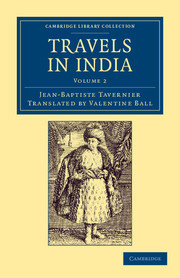Travels in India Travels in India 2 volume Set Series
Langue : Anglais
Auteur : Tavernier Jean-Baptiste

An 1889 translation of the account of his Indian travels by French merchant Jean-Baptiste Tavernier (1605–89).
In 1676, Jean-Baptiste Tavernier (1605?89), French merchant, traveller and pioneer of trade with India, published an account of his journey through India. This two-volume translation, published in 1889 by Irish geologist Valentine Ball (1843?94), includes a biographical sketch of the author, notes and appendices. Tavernier begins his tale with the declaration that 'I came into this world to travel.' As well as most of Europe, he visited large areas of Turkey, Persia and India (where he acquired the great gem, now known as the Hope Diamond, which he sold to Louis XIV), and sailed to Java. Volume 2 continues his history of India, and describes Hindi and Muslim religious practices; Tavernier then continues to the Dutch territories in the East Indies and returns home on a Dutch ship via St Helena. Tavernier's interest in the details of everything he saw makes this work a fascinating read.
Book II continued. Historical and Political Description of the Empire of the Great Mogul: 12. Concerning the articles of merchandise yielded by the Empire of the Great Mogul, and the Kingdoms of Golconda and Bijapur and other neighbouring territories; 13. Concerning the frauds which can be practised in manufactures, whether by the roguery of the workers or the knavery of the brokers and buyers; 14. Concerning the methods to be observed for establishing a new commercial company in the East Indies; 15. Concerning diamonds and the mines and rivers where they are found; and especially of the author's journey to the Mine of Ramulkota (Raolconda of the original); 16. Journey of the author to the other mines, and concerning the method of searching for diamonds; 17. A continuation of the author's journeys to the diamond mines; 18. The different kinds of weights for weighing diamonds at the mines; the kinds of gold and silver in circulation; the routes by which one is able to travel; and the rule in use for the estimation of the prices of diamonds; 19. Concerning coloured stones and the places where they are obtained; 20. Concerning pearls and the places where they are fished for; 21. Concerning the manner in which pearls originate in oysters, how they are fished for and at what seasons; 22. Remarks upon the largest and most beautiful diamonds and rubies which the author has seen in Europe and Asia, the figures of which are here given, together with those of the large stones which he sold to the King on his return from his last journey to India, with a representation of a magnificent topaz, and the largest pearls in the world; 23. Concerning coral and yellow amber and the places where they are found; 24. Concerning musk and bezoar and some other medicinal stones; 25. Concerning the places from whence gold is obtained in Asia and Africa; 26. Account of a notable act of perfidy done to the author when he was about to embark at Gombroon for Surat; Book III. Concerning the Religion of the Muhammadans and that of the Idolaters of India: the Voyage of the Author by Sea from Surat to Batavia, and from Batavia to Holland; and of Many Peculiarities in Different Kingdoms of the East: 1. Concerning the religion of the Muhammadans in the East Indies; 2. Concerning fakirs or Muhammadan beggars in the East Indies; 3. Of the religion of the gentiles or idolaters of India; 4. Concerning the idolatrous Kings and Princes of Asia; 5. Concerning the belief of the idolaters with respect to the deity; 6. Concerning fakirs, or the professional mendicants of India, and their penances; 7. Concerning the belief of the idolaters touching the condition of the soul of man after death; 8. Concerning the idolaters' customs of burning the bodies of the deceased; 9. How the women burn themselves with the bodies of their deceased husbands in India; 10. Remarkable histories of several women who have been burnt after the death of their husbands; 11. Concerning the most celebrated pagodas of the idolaters of India; 12. Continuation of the description of the principal pagodas of the idolaters of India; 13. Concerning the pilgrimages of the idolaters to their pagodas; 14. Concerning various customs of the idolaters of India; 15. Concerning the Kingdom of Bhután, from whence comes musk, good rhubarb, and some furs; 16. Concerning the Kingdom of Tipperah; 17. Concerning the Kingdom of Assam; 18. Concerning the Kingdom of Siam; 19. Concerning the Kingdom of Macassar and the Dutch Embassy to China; 20. The author pursues his journey in the east and embarks at Vengurla for Batavia; the danger which he runs on the sea, and his arrival in the Island of Ceylon; 21. Departure of the author from the Island of Ceylon, and his arrival at Batavia; 22. Concerning an affair which was raised unseasonably for the author in the Council at Batavia; 23. The author goes to see the King
Date de parution : 05-2012
Ouvrage de 538 p.
14x21.6 cm
Thème de Travels in India :
© 2024 LAVOISIER S.A.S.



